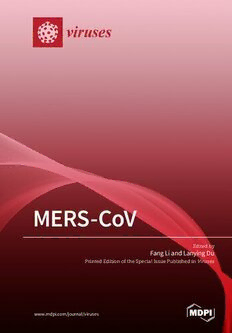Table Of ContentMERS-CoV
Edited by
Fang Li and Lanying Du
Printed Edition of the Special Issue Published in Viruses
www.mdpi.com/journal/viruses
MERS-CoV
MERS-CoV
SpecialIssueEditors
FangLi
LanyingDu
MDPI•Basel•Beijing•Wuhan•Barcelona•Belgrade
Special Issue Editors
Fang Li LanyingDu
Department of Veterinary ViralImmunologyLaboratory,
and Biomedical Sciences, LindsleyF.KimballResearchInstitute,
University of Minnesota NewYorkBloodCenter
USA USA
EditorialOffice
MDPI
St.Alban-Anlage66
4052Basel,Switzerland
ThisisareprintofarticlesfromtheSpecialIssuepublishedonlineintheopenaccessjournalViruses
(ISSN1999-4915)from2018to2019(availableat: https://www.mdpi.com/journal/viruses/special
issues/MERSCoV).
Forcitationpurposes,citeeacharticleindependentlyasindicatedonthearticlepageonlineandas
indicatedbelow:
LastName,A.A.; LastName,B.B.; LastName,C.C.ArticleTitle. JournalNameYear,ArticleNumber,
PageRange.
ISBN978-3-03921-850-9(Pbk)
ISBN978-3-03921-851-6(PDF)
(cid:2)c 2019bytheauthors. ArticlesinthisbookareOpenAccessanddistributedundertheCreative
Commons Attribution (CC BY) license, which allows users to download, copy and build upon
publishedarticles,aslongastheauthorandpublisherareproperlycredited,whichensuresmaximum
disseminationandawiderimpactofourpublications.
ThebookasawholeisdistributedbyMDPIunderthetermsandconditionsoftheCreativeCommons
licenseCCBY-NC-ND.
Contents
AbouttheSpecialIssueEditors . . . . . . . . . . . . . . . . . . . . . . . . . . . . . . . . . . . . . vii
FangLiandLanyingDu
MERSCoronavirus:AnEmergingZoonoticVirus
Reprintedfrom:Viruses2019,11,663,doi:10.3390/v11070663 . . . . . . . . . . . . . . . . . . . . . 1
ElmoubasherFarag,ReinaS.Sikkema,TinkaVinks,MdMazharulIslam,MohamedNour,
Hamad Al-Romaihi, Mohammed Al Thani, Muzzamil Atta, Farhoud H. Alhajri, Salih
Al-Marri,MohdAlHajri,ChantalReuskenandMarionKoopmans
DriversofMERS-CoVEmergenceinQatar
Reprintedfrom:Viruses2019,11,22,doi:10.3390/v11010022 . . . . . . . . . . . . . . . . . . . . . 7
ZhiqiSong,YanfengXu,LinlinBao,LingZhang,PinYu,YajinQu,HuaZhu,WenjieZhao,
YunlinHanandChuanQin
FromSARStoMERS,ThrustingCoronavirusesintotheSpotlight
Reprintedfrom:Viruses2019,11,59,doi:10.3390/v11010059 . . . . . . . . . . . . . . . . . . . . . 22
W.Widagdo,SyriamSooksawasdiNaAyudhya,GadissaB.HundieandBartL.Haagmans
HostDeterminantsofMERS-CoVTransmissionandPathogenesis
Reprintedfrom:Viruses2019,11,280,doi:10.3390/v11030280 . . . . . . . . . . . . . . . . . . . . . 50
Bingpeng Yan, Hin Chu, Dong Yang, Kong-Hung Sze, Pok-Man Lai, Shuofeng Yuan,
HuipingShuai, YixinWang, RichardYi-TsunKao, JasperFuk-WooChanandKwok-Yung
Yuen
CharacterizationoftheLipidomicProfileofHumanCoronavirus-InfectedCells: Implications
forLipidMetabolismRemodelinguponCoronavirusReplication
Reprintedfrom:Viruses2019,11,73,doi:10.3390/v11010073 . . . . . . . . . . . . . . . . . . . . . 64
W. Widagdo, Nisreen M.A. Okba, Mathilde Richard, Dennis de Meulder, Theo M.
Bestebroer, Pascal Lexmond, Elmoubasher A.B.A. Farag, Mohammed Al-Hajri, Koert J.
Stittelaar, Leon de Waal, Geert van Amerongen, Judith M.A. van den Brand, Bart L.
HaagmansandSanderHerfst
LackofMiddleEastRespiratorySyndromeCoronavirusTransmissioninRabbits
Reprintedfrom:Viruses2019,11,381,doi:10.3390/v11040381 . . . . . . . . . . . . . . . . . . . . . 80
ChangfaFan,XiWu,QiangLiu,QianqianLi,SusuLiu,JianjunLu,YanweiYang,YuanCao,
WeijinHuang,ChunnanLiang,TianleiYing,ShiboJiangandYouchunWang
A Human DPP4-Knockin Mouse’s Susceptibility to Infection by Authentic and
PseudotypedMERS-CoV
Reprintedfrom:Viruses2018,10,448,doi:10.3390/v10090448 . . . . . . . . . . . . . . . . . . . . . 93
YusenZhou,YangYang,JingweiHuang,ShiboJiangandLanyingDu
AdvancesinMERS-CoVVaccinesandTherapeuticsBasedontheReceptor-BindingDomain
Reprintedfrom:Viruses2019,11,60,doi:10.3390/v11010060 . . . . . . . . . . . . . . . . . . . . . 113
CraigSchindewolfandVineetD.Menachery
MiddleEastRespiratorySyndromeVaccineCandidates:CautiousOptimism
Reprintedfrom:Viruses2019,11,74,doi:10.3390/v11010074 . . . . . . . . . . . . . . . . . . . . . 131
v
Danielle R. Adney, Lingshu Wang, Neeltje van Doremalen, Wei Shi, Yi Zhang, Wing-Pui
Kong,MeganR.Miller,TrentonBushmaker,DanaScott,EmmiedeWit,KayvonModjarrad,
NikolaiPetrovsky,BarneyS.Graham,RichardA.BowenandVincentJ.Munster
Efficacy of an Adjuvanted Middle East Respiratory Syndrome Coronavirus Spike Protein
VaccineinDromedaryCamelsandAlpacas
Reprintedfrom:Viruses2019,11,212,doi:10.3390/v11030212 . . . . . . . . . . . . . . . . . . . . . 148
SvenjaVeit,SylviaJany,RobertFux,GerdSutterandAsisaVolz
CD8+TCellsRespondingtotheMiddleEastRespiratorySyndromeCoronavirusNucleocapsid
ProteinDeliveredbyVacciniaVirusMVAinMice
Reprintedfrom:Viruses2018,10,718,doi:10.3390/v10120718 . . . . . . . . . . . . . . . . . . . . . 161
LeiHe,WanboTai,JiangfanLi,YuehongChen,YaningGao,JunfengLi,ShihuiSun,Yusen
Zhou,LanyingDuandGuangyuZhao
Enhanced Ability of Oligomeric Nanobodies Targeting MERS Coronavirus
Receptor-BindingDomain
Reprintedfrom:Viruses2019,11,166,doi:10.3390/v11020166 . . . . . . . . . . . . . . . . . . . . . 179
Hui-JuHan,Jian-WeiLiu,HaoYuandXue-JieYu
Neutralizing Monoclonal Antibodies as Promising Therapeutics against Middle East
RespiratorySyndromeCoronavirusInfection
Reprintedfrom:Viruses2018,10,680,doi:10.3390/v10120680 . . . . . . . . . . . . . . . . . . . . . 193
ShuaiXia,QiaoshuaiLan,JingPu,CongWang,ZezhongLiu,WeiXu,QianWang,HuanLiu,
ShiboJiangandLuLu
PotentMERS-CoVFusionInhibitoryPeptidesIdentifiedfromHR2DomaininSpikeProteinof
BatCoronavirusHKU4
Reprintedfrom:Viruses2019,11,56,doi:10.3390/v11010056 . . . . . . . . . . . . . . . . . . . . . 203
CongWang,ChenHua,ShuaiXia,WeihuaLi,LuLuandShiboJiang
CombiningaFusionInhibitoryPeptideTargetingtheMERS-CoVS2ProteinHR1Domainand
aNeutralizingAntibodySpecificfortheS1ProteinReceptor-BindingDomain(RBD)Showed
PotentSynergismagainstPseudotypedMERS-CoVwithorwithoutMutationsinRBD
Reprintedfrom:Viruses2019,11,31,doi:10.3390/v11010031 . . . . . . . . . . . . . . . . . . . . . 215
YutingJiang,JunfengLi,YueTeng,HongSun,GuangTian,LeiHe,PeiLi,YuehongChen,
YanGuo,JiangfanLi,GuangyuZhao,YusenZhouandShihuiSun
Complement Receptor C5aR1 Inhibition Reduces Pyroptosis in hDPP4-Transgenic Mice
InfectedwithMERS-CoV
Reprintedfrom:Viruses2019,11,39,doi:10.3390/v11010039 . . . . . . . . . . . . . . . . . . . . . 227
RuiyingLiang,LiliWang,NaruZhang,XiaoqianDeng,MengSu,YudanSu,LanfangHu,
ChenHe,TianleiYing,ShiboJiangandFeiYu
DevelopmentofSmall-MoleculeMERS-CoVInhibitors
Reprintedfrom:Viruses2018,10,721,doi:10.3390/v10120721 . . . . . . . . . . . . . . . . . . . . . 240
vi
About the Special Issue Editors
FangLiisanAssociateProfessorintheDepartmentofVeterinaryandBiomedicalSciencesatthe
UniversityofMinnesota. Hismainlineofresearchexaminestheinvasionmechanismsofviruses.
Specifically,hisgroupinvestigatesthestructuresandfunctionsofvirus-surfaceproteinsthatmediate
receptor recognition and cell entry of viruses. His other line of research explores the structural
and molecular basis for cancer and abnormal blood pressure. Specifically, his group investigates
the structures and functions of mammalian-cell-surface enzymes that are critical for tumor cell
growthandbloodpressureregulation. Basedonthesestructuralandfunctionalstudies,hisgroup
furtherdevelopsnoveltherapystrategiestotreathumandiseases. HisresearchtoolsincludeX-ray
crystallography,cryo-electronmicroscopy,proteinbiochemistry,molecularvirology,andvaccineand
drugdesigns.
Lanying Du is an Associate Member and Head of Viral Immunology Laboratory at Lindsley
F. Kimball Research Institute of New York Blood Center, USA. Her research focuses are to:
(1) design and develop effective and safe vaccines and therapeutic agents against coronaviruses
(including MERS-CoV, SARS-CoV, and other coronaviruses with pandemic potential), influenza
viruses, and flaviviruses (including the Zika virus and dengue virus); (2) understand protective
mechanismsofthedevelopedvaccinesandtherapeutics; and(3)studypathogenicmechanismsof
theseviruses,basedonwhichtodesignnovelvaccinesandtherapeutics. Herresearchtoolsinclude
structure-based design of novel vaccines and therapeutics, mRNA technology, drug screening,
andantibodyproductionandevaluation.
vii
viruses
Editorial
MERS Coronavirus: An Emerging Zoonotic Virus
FangLi1,*andLanyingDu2,*
1 DepartmentofVeterinaryandBiomedicalSciences,CollegeofVeterinaryMedicine,UniversityofMinnesota,
SaintPaul,MN55108,USA
2 LindsleyF.KimballResearchInstitute,NewYorkBloodCenter,NewYork,NY10065,USA
* Correspondence:[email protected](F.L.);[email protected](L.D.);
Tel.:+1-612-625-6149(F.L.);+1-212-570-3459(L.D.)
Received:16July2019;Accepted:17July2019;Published:19July2019
Middle East respiratory syndrome coronavirus (MERS-CoV) is an emerging virus that was
firstreportedinhumansinJune2012[1]. Todate, MERS-CoVcontinuestoinfecthumanswith
a fatality rate of ~35%. At least 27 countries have reported human infections with MERS-CoV
(https://www.who.int/emergencies/mers-cov/en/).MERS-CoVisazoonoticvirus.Likesevereacute
respiratory syndrome coronavirus (SARS-CoV), MERS-CoV is believed to have originated from
bats[2,3]. However,whereasthebat-to-humantransmissionofSARS-CoVwaslikelymediatedby
palmcivetsasintermediatehosts,humanslikelyacquiredMERS-CoVfromdromedarycamels[4–6].
Human-to-humantransmissionofMERS-CoVdoesoccur, butitislimitedmostlytohealthcare
environments [7,8]. Moreover, whereas SARS-CoV recognizes angiotensin-converting enzyme 2
(ACE2)asacellularreceptor[9,10],MERS-CoVusesdipeptidylpeptidase4(DPP4)toentertarget
cells[11,12].Currently,novaccinesorantiviraltherapeuticshavebeenapprovedfortheprevention
ortreatmentofMERS-CoVinfection,althoughanumberofthemhavebeendevelopedpreclinically
and/ortestedclinically[13–16].
ThearticlesinthisspecialissueofViruseswerewrittenbyresearchersworkingintheMERS-CoV
field.Themainaimsofthisissueareto(i)betterunderstandMERS-CoVtransmission,epidemiology,and
pathogenesis;(ii)summarizecurrentprogressonMERS-CoVanimalmodels,vaccines,andtherapeutics;
and(iii)discussfutureprospectsforMERS-CoVresearch.Thisissueincludessevenreviewarticles
andnineoriginalresearchpapers,eachprovidingdetailedupdatesoncurrentMERS-CoVstudies.
Studiesonthetransmission,epidemiology,andpathogenesisofMERS-CoVformoneofthe
foundationsofMERS-CoVresearch. Inthisissue, Faragandcolleaguessummarizethepossible
driversoftheemergenceofMERS-CoVanditsspillovertohumansinQatar,explainingthepotential
reasonsforthecamel-to-humantransmissionofMERS-CoV[17]. ThereviewarticlebySongand
colleaguesprovidesanoveralldescriptionoftheepidemiology,pathogenesis,andotherimportant
aspectsofMERS-CoV[18].Widagdoandcolleaguesreviewthehostdeterminantsofthetransmission
and pathogenesis of MERS-CoV, indicating that receptor DPP4 plays an important role in these
processes[19].AresearcharticlebyYanandcolleaguescharacterizestheroleoflipidprofilesinthe
pathogenesisandinfectivityofhumancoronaviruses,includingMERS-CoV,suggestingthatlipid
metabolismmaybeinvolvedinthepropagationsofthesecoronaviruses[20].Thesereportsprovide
insightsintohowMERS-CoVinfectscellsandspreadswithinandacrosshostspecies.Theyhavealso
laidthefoundationsfordevelopinganimalmodels.
Animalmodelsareessentialtoolsforthepreclinicalevaluationofanti-MERS-CoVcountermeasures.
Dromedarycamels,alpacas,andnon-humanprimatesaresusceptibletoMERS-CoVinfection[21–23];
however,thevirusdoesnotinfectsmallanimalssuchasmice,hamsters,andferrets[24–26].Several
mousemodelsthatexpresshumanDPP4(hDPP4)havebeenestablishedforMERS-CoVinfection[27–29].
Inthisissue,WidagdoandcolleaguesexaminerabbitsaspotentialhostsforMERS-CoV,showing
thatMERS-CoVinfectsrabbitswithoutcausingsymptoms;theyalsoanalyzetherouteofMERS-CoV
Viruses2019,11,663;doi:10.3390/v11070663 1 www.mdpi.com/journal/viruses

